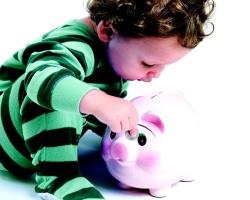Many of the financial pitfalls people fall into as adults could have been prevented with some solid financial education as children.
Lori Mackey, author of Money Mama & The Three Little Pigs and creator of the Prosperity 4 Kids Web site (www.prosperity4kids.com), says there’s no substitute for teaching children early about how to spend and save money—and she has the stats to back it up.
In her online workbook, Design Your Child’s Financial Future, Mackey relays the (fictional) story of Brandy and Brian: Brandy, at age 11, decided she’d invest $500 a year until she was 24. Brian spent his money on Hot Wheels cars and only took investing seriously at age 40, when he started squirreling away $5,000 a year until he was 65.
Who had more money by retirement? Brandy, hands down: The wonder of compound interest allowed her to accumulate more than $705,000 from her measly $5,500 investment. Brian, meanwhile, had about $635,000 to play with.
“My target age range is grammar school, due to the fact that this is the perfect age for learning and understanding new concepts,” Mackey writes to YouthWorker Journal. “Kids in kindergarten to fifth grade also are developing their lifetime habits, and this is the perfect age to instill positive habits around money that will carry into their adult lives.”
Mackey believes in the standard 10/10/10/70 breakdown system for investing—that is, 10 percent of one’s income goes to giving, 10 to investing, 10 to a standard savings account and the other 70 percent can be spent (frugally). But in her workbook and on her Web site, Mackey also stresses the importance of encouraging your children to plan, to dream and to think creatively. After all, few people get really wealthy just working 9 to 5.
Those who visit Mackey’s site and read her books may wish they’d gotten advice like this earlier in their own lives—like about the age they were spending all their money on Hot Wheels cars.




